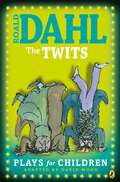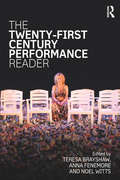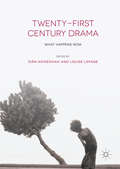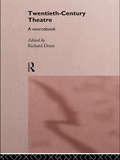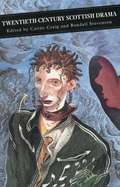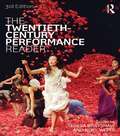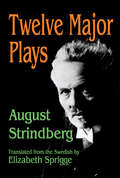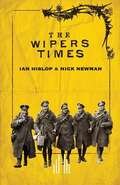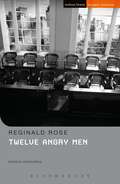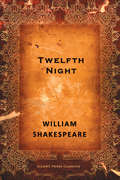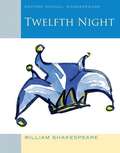- Table View
- List View
The Twits: Plays for Children (The\raven Rock Primary Novel Study Collection)
by Roald Dahl David WoodA collection of six fun-to-perform playlets based on Roald Dahl's bestselling story.Each short play, based on THE TWITS, highlights the key points in the story and some can be acted by groups of children while others only need a couple of actors.Similar format to the The BFG, and The Witches: Plays for ChildrenAdapted by David Wood, a central figure in children's theatre (most recently Goodnight Mister Tom).
Twist of Gold (Oberon Modern Plays)
by Michael Morpurgo Simon ReadeWith famine gripping Ireland, Sean and Annie have just one chance of survival - they must find their father. Leaving their dying mother behind, they travel across rough seas to America. With only the gold torch that Annie wears as a necklace to protect them, they embark on a long and dangerous journey. But will they ever be reunited with their family?Twist of Gold is an epic adventure, a classic novel by the masterful storyteller and author of War Horse, Michael Morpurgo.
Twins in Early Modern English Drama and Shakespeare (Routledge Studies in Renaissance Literature and Culture)
by Daisy MurrayThis volume investigates the early modern understanding of twinship through new readings of plays, informed by discussions of twins appearing in such literature as anatomy tracts, midwifery manuals, monstrous birth broadsides, and chapbooks. The book contextualizes such dramatic representations of twinship, investigating contemporary discussions about twins in medical and popular literature and how such dialogues resonate with the twin characters appearing on the early modern stage. Garofalo demonstrates that, in this period, twin births were viewed as biologically aberrant and, because of this classification, authors frequently attempt to explain the phenomenon in ways which call into question the moral and constitutional standing of both the parents and the twins themselves. In line with current critical studies on pregnancy and the female body, discussions of twin births reveal a distrust of the mother and the processes surrounding twin conception; however, a corresponding suspicion of twins also emerges, which monstrous birth pamphlets exemplify. This book analyzes the representation of twins in early modern drama in light of this information, moving from tragedies through to comedies. This progression demonstrates how the dramatic potential inherent in the early modern understanding of twinship is capitalized on by playwrights, as negative ideas about twins can be seen transitioning into tragic and tragicomic depictions of twinship. However, by building toward a positive, comic representation of twins, the work additionally suggests an alternate interpretation of twinship in this period, which appreciates and celebrates twins because of their difference. The volume will be of interest to those studying Shakespeare and Renaissance Literature in relation to the History of Emotions, the Body, and the Medical Humanities.
Twins in Early Modern English Drama and Shakespeare (Routledge Studies in Renaissance Literature and Culture)
by Daisy MurrayThis volume investigates the early modern understanding of twinship through new readings of plays, informed by discussions of twins appearing in such literature as anatomy tracts, midwifery manuals, monstrous birth broadsides, and chapbooks. The book contextualizes such dramatic representations of twinship, investigating contemporary discussions about twins in medical and popular literature and how such dialogues resonate with the twin characters appearing on the early modern stage. Garofalo demonstrates that, in this period, twin births were viewed as biologically aberrant and, because of this classification, authors frequently attempt to explain the phenomenon in ways which call into question the moral and constitutional standing of both the parents and the twins themselves. In line with current critical studies on pregnancy and the female body, discussions of twin births reveal a distrust of the mother and the processes surrounding twin conception; however, a corresponding suspicion of twins also emerges, which monstrous birth pamphlets exemplify. This book analyzes the representation of twins in early modern drama in light of this information, moving from tragedies through to comedies. This progression demonstrates how the dramatic potential inherent in the early modern understanding of twinship is capitalized on by playwrights, as negative ideas about twins can be seen transitioning into tragic and tragicomic depictions of twinship. However, by building toward a positive, comic representation of twins, the work additionally suggests an alternate interpretation of twinship in this period, which appreciates and celebrates twins because of their difference. The volume will be of interest to those studying Shakespeare and Renaissance Literature in relation to the History of Emotions, the Body, and the Medical Humanities.
The Twilight Zone: Based On Stories By Rod Serling, Charles Beaumont And Richard Matheson (Oberon Modern Plays)
by Rod Serling Richard Matheson Charles Beaumont Anne WashburnBetween light and shadow, science and superstition, fear and knowledge, is a dimension of imagination. An area we call the Twilight Zone.Adapted by Anne Washburn (Mr Burns) and directed by Olivier Award-winner Richard Jones, this world premiere production of the acclaimed CBS Television Series The Twilight Zone lands on stage for the first time in its history. Or its present. Or its future.
The Twenty-First Century Performance Reader
by Teresa Brayshaw Anna Fenemore Noel WittsThe Twenty-First Century Performance Reader combines extracts from over 70 international practitioners, companies, collectives and makers from the fields of Dance, Theatre, Music, Live and Performance Art, and Activism to form an essential sourcebook for students, researchers and practitioners. This is the follow-on text from The Twentieth-Century Performance Reader, which has been the key introductory text to all kinds of performance for over 20 years since it was first published in 1996. Contributions from new and emerging practitioners are placed alongside those of long-established individual artists and companies, representing the work of this century’s leading practitioners through the voices of over 140 individuals. The contributors in this volume reflect the diverse and eclectic culture of practices that now make up the expanded field of performance, and their stories, reflections and working processes collectively offer a snapshot of contemporary artistic concerns. Many of the pieces have been specially commissioned for this edition and comprise a range of written forms – scholarly, academic, creative, interviews, diary entries, autobiographical, polemical and visual. Ideal for university students and instructors, this volume’s structure and global span invites readers to compare and cross-reference significant approaches outside of the constraints and simplifications of genre, encouraging cross-disciplinary understandings. For those who engage with new, live and innovative approaches to performance and the interplay of radical ideas, The Twenty-First Century Performance Reader is invaluable.
The Twenty-First Century Performance Reader
by Teresa Brayshaw Anna Fenemore Noel WittsThe Twenty-First Century Performance Reader combines extracts from over 70 international practitioners, companies, collectives and makers from the fields of Dance, Theatre, Music, Live and Performance Art, and Activism to form an essential sourcebook for students, researchers and practitioners. This is the follow-on text from The Twentieth-Century Performance Reader, which has been the key introductory text to all kinds of performance for over 20 years since it was first published in 1996. Contributions from new and emerging practitioners are placed alongside those of long-established individual artists and companies, representing the work of this century’s leading practitioners through the voices of over 140 individuals. The contributors in this volume reflect the diverse and eclectic culture of practices that now make up the expanded field of performance, and their stories, reflections and working processes collectively offer a snapshot of contemporary artistic concerns. Many of the pieces have been specially commissioned for this edition and comprise a range of written forms – scholarly, academic, creative, interviews, diary entries, autobiographical, polemical and visual. Ideal for university students and instructors, this volume’s structure and global span invites readers to compare and cross-reference significant approaches outside of the constraints and simplifications of genre, encouraging cross-disciplinary understandings. For those who engage with new, live and innovative approaches to performance and the interplay of radical ideas, The Twenty-First Century Performance Reader is invaluable.
Twenty-First Century Musicals: From Stage to Screen
by George RodosthenousTwenty-First Century Musicals stakes a place for the musical in today’s cinematic landscape, taking a look at leading contemporary shows from their stage origins to their big-screen adaptations. Each chapter offers a new perspective on a single musical, challenging populist narratives and exploring underlying narratives and sub-texts in depth. Themes of national identity; race, class and gender; the ‘voice’ and ‘singing live’ on film; authenticity; camp sensibilities; and the celebration of failure are addressed in a series of questions including: How does the film adaptation provide a different viewing experience from the stage version? What themes are highlighted in the film adaptation? What does the new casting bring to the work? Do camera angles dictate a different reading from the stage version? What is lost/gained in the process of adaptation to film? Re-interpreting the contemporary film musical as a compelling art form, Twenty-First Century Musicals is a must-read for any student or scholar keen to broaden their understanding of musical performance.
Twenty-First Century Musicals: From Stage to Screen
by George RodosthenousTwenty-First Century Musicals stakes a place for the musical in today’s cinematic landscape, taking a look at leading contemporary shows from their stage origins to their big-screen adaptations. Each chapter offers a new perspective on a single musical, challenging populist narratives and exploring underlying narratives and sub-texts in depth. Themes of national identity; race, class and gender; the ‘voice’ and ‘singing live’ on film; authenticity; camp sensibilities; and the celebration of failure are addressed in a series of questions including: How does the film adaptation provide a different viewing experience from the stage version? What themes are highlighted in the film adaptation? What does the new casting bring to the work? Do camera angles dictate a different reading from the stage version? What is lost/gained in the process of adaptation to film? Re-interpreting the contemporary film musical as a compelling art form, Twenty-First Century Musicals is a must-read for any student or scholar keen to broaden their understanding of musical performance.
Twenty-First Century Drama: What Happens Now
by Siân Adiseshiah Louise LePageWithin this landmark collection, original voices from the field of drama provide rich analysis of a selection of the most exciting and remarkable plays and productions of the twenty-first century. But what makes the drama of the new millenium so distinctive? Which events, themes, shifts, and paradigms are marking its stages? Kaleidoscopic in scope, Twenty-First Century Drama: What Happens Now creates a broad, rigorously critical framework for approaching the drama of this period, including its forms, playwrights, companies, institutions, collaborative projects, and directors. The collection has a deliberately British bent, examining established playwrights – such as Churchill, Brenton, and Hare – alongside a new generation of writers – including Stephens, Prebble, Kirkwood, Bartlett, and Kelly. Simultaneously international in scope, it engages with significant new work from the US, Japan, India, Australia, and the Netherlands, to reflect a twenty-first century context that is fundamentally globalized. The volume’s central themes – the financial crisis, austerity, climate change, new forms of human being, migration, class, race and gender, cultural politics and issues of nationhood – are mediated through fresh, cutting-edge perspectives.
Twentieth Century Theatre: A Sourcebook
by Richard DrainTwentieth Century Theatre: A Sourcebook is an inspired handbook of ideas and arguments on theatre. Richard Drain gathers together a uniquely wide-ranging selection of original writings on theatre by its most creative practitioners - directors, playwrights, performers and designers, from Jarry to Grotowski and Craig. These key texts span the twentieth century, from the onset of modernism to the present, providing direct access to the thinking behind much of the most stimulating theatre the century has had to offer, as well as guidelines to its present most adventurous developments. Setting theory beside practice, these writings bring alive a number of vital and continuing concerns, each of which is given full scope in five sections which explore the Modernist, Political, Inner and Global dimensions of twentieth century theatre. Twentieth Century Theatre: A Sourcebook provides illuminationg perspectives on past history, and throws fresh light on the sources and development of theatre today. This sourcebook is not only an essential and versatile collection for students at all levels, but also directed numerous devised shows which have toured to theatres, schools, community centres and prisons.
Twentieth Century Theatre: A Sourcebook
by Richard DrainTwentieth Century Theatre: A Sourcebook is an inspired handbook of ideas and arguments on theatre. Richard Drain gathers together a uniquely wide-ranging selection of original writings on theatre by its most creative practitioners - directors, playwrights, performers and designers, from Jarry to Grotowski and Craig. These key texts span the twentieth century, from the onset of modernism to the present, providing direct access to the thinking behind much of the most stimulating theatre the century has had to offer, as well as guidelines to its present most adventurous developments. Setting theory beside practice, these writings bring alive a number of vital and continuing concerns, each of which is given full scope in five sections which explore the Modernist, Political, Inner and Global dimensions of twentieth century theatre. Twentieth Century Theatre: A Sourcebook provides illuminationg perspectives on past history, and throws fresh light on the sources and development of theatre today. This sourcebook is not only an essential and versatile collection for students at all levels, but also directed numerous devised shows which have toured to theatres, schools, community centres and prisons.
Twentieth Century Scottish Drama (Canongate Classics #98)
by Cairns Craig Randall StevensEdited and introduced by Cairns Craig and Randall Stevenson. Ever since the major revival of dramatic writing and production in the 1970s, the style and the subject matter of Scottish writing for stage and screen has been a continuing influence on our contemporary culture, exciting, offending and challenging audiences in equal measure. Yet modern Scottish drama has a history of controversy, conflict and entertainment going back to the 1920s, notable at every turn for the vigour of its language and its direct confrontation with telling issues. The plays in this anthology offer a unique chance to grasp the different topics and also the recurrent themes of Scottish drama in the twentieth century. Gathered together in a single omnibus volume, there is the poetic eeriness of Barrie and the political commitment of Joe Corrie and Sue Glover; there is the Brechtian debate of Bridie and the verbal brilliance of John Byrne and Liz Lochhead; there is working-class experience and feminist insight; broad Scots and existential anxiety; street realism and a meeting with the devil; social injustice and raucous humour; historical comedy and tragic loss. Here is both the breadth and the continuity of the modern Scottish tradition in a single volume.
The Twentieth Century Performance Reader
by Teresa Brayshaw Noel WittsThe Twentieth-Century Performance Reader has been the key introductory text to all types of performance for over fifteen years. Extracts from over fifty practitioners, critics and theorists from the fields of dance, drama, music, theatre and live art form an essential sourcebook for students, researchers and practitioners. This carefully revised third edition offers focus on contributions from the world of music, and also privileges the voices of practitioners themselves ahead of more theoretical writing. A bestseller since its original publication in 1996, this new edition has been expanded to include contributions from: Bobby Baker; Joseph Beuys; Rustom Bharucha; Anne Teresa de Keersmaeker; Hanns Eisler; Karen Finley; Philip Glass; Guillermo Gómez-Peña; Matthew Goulish; Martha Graham; Wassily Kandinsky; Jacques Lecoq; Hans-Thies Lehmann; George Maciunas; Ariane Mnouchkine; Meredith Monk; Lloyd Newson; Carolee Schneemann; Gertrude Stein; Bill Viola. Each extract is fully supplemented by a contextual summary, a biography of the writer, and suggestions for further reading. The volume’s alphabetical structure invites the reader to compare and cross-reference major writings on all types of performance outside of the constraints and simplifications of genre, encouraging cross-disciplinary understandings. All who engage with live, innovative performance, and the interplay of radical ideas, will find this collection invaluable.
The Twentieth Century Performance Reader
by Teresa Brayshaw Noel WittsThe Twentieth-Century Performance Reader has been the key introductory text to all types of performance for over fifteen years. Extracts from over fifty practitioners, critics and theorists from the fields of dance, drama, music, theatre and live art form an essential sourcebook for students, researchers and practitioners. This carefully revised third edition offers focus on contributions from the world of music, and also privileges the voices of practitioners themselves ahead of more theoretical writing. A bestseller since its original publication in 1996, this new edition has been expanded to include contributions from: Bobby Baker; Joseph Beuys; Rustom Bharucha; Anne Teresa de Keersmaeker; Hanns Eisler; Karen Finley; Philip Glass; Guillermo Gómez-Peña; Matthew Goulish; Martha Graham; Wassily Kandinsky; Jacques Lecoq; Hans-Thies Lehmann; George Maciunas; Ariane Mnouchkine; Meredith Monk; Lloyd Newson; Carolee Schneemann; Gertrude Stein; Bill Viola. Each extract is fully supplemented by a contextual summary, a biography of the writer, and suggestions for further reading. The volume’s alphabetical structure invites the reader to compare and cross-reference major writings on all types of performance outside of the constraints and simplifications of genre, encouraging cross-disciplinary understandings. All who engage with live, innovative performance, and the interplay of radical ideas, will find this collection invaluable.
Twelve Major Plays
by August StrindbergAugust Strindberg is one of the founders of the modern theater. George Bernard Shaw considered him "the only genuinely Shakespearian modern dramatist," Sean O'Casey called him "the greatest of them all." And to Eugene O'Neill he was "the greatest interpreter in the theater of the characteristic spiritual conflicts of our lives today." Twelve Major Plays includes the most famous and most characteristic Strindberg plays.This selection is particularly interesting in its depiction of the great range of Strindberg's moods and styles, from naturalism to expressionism, from ironic comedy to bitter tragedy. It displays his great gift for symbolic, mystical verse as well as his command of dramatic prose. In issues of sex and gender, Strindberg anticipated the modern temperament in society and drama alike.These translations gave American readers their first opportunity to know the true genius of Strindberg. Most previous versions in English had been based on existing German translations. Elizabeth Sprigge's unique achievement was to render the original Swedish texts into English that is at once fluent and accurate and that captures the full vigor and impact of the original plays.
Twelve Major Plays
by August StrindbergAugust Strindberg is one of the founders of the modern theater. George Bernard Shaw considered him "the only genuinely Shakespearian modern dramatist," Sean O'Casey called him "the greatest of them all." And to Eugene O'Neill he was "the greatest interpreter in the theater of the characteristic spiritual conflicts of our lives today." Twelve Major Plays includes the most famous and most characteristic Strindberg plays.This selection is particularly interesting in its depiction of the great range of Strindberg's moods and styles, from naturalism to expressionism, from ironic comedy to bitter tragedy. It displays his great gift for symbolic, mystical verse as well as his command of dramatic prose. In issues of sex and gender, Strindberg anticipated the modern temperament in society and drama alike.These translations gave American readers their first opportunity to know the true genius of Strindberg. Most previous versions in English had been based on existing German translations. Elizabeth Sprigge's unique achievement was to render the original Swedish texts into English that is at once fluent and accurate and that captures the full vigor and impact of the original plays.
Twelve Angry Men (Student Editions)
by Reginald Rose Steven PriceThe Methuen Drama Student Edition of Twelve Angry Men is the first critical edition of Reginald Rose's play, providing the play text alongside commentary and notes geared towards student readers.In New York, 1954, a man is dead and the life of another is at stake. A 'guilty' verdict seems a foregone conclusion, but one member of the jury has the will to probe more deeply into the evidence and the courage to confront the ignorance and prejudice of some of his fellow jurors. The conflict that follows is fierce and passionate, cutting straight to the heart of the issues of civil liberties and social justice. Ideal for the student reader, the accompanying pedagogical notes include elements such as an author chronology; plot summary; suggested further reading; explanatory endnotes; and questions for further study. The introduction discusses in detail the play's origins as a 1954 American television play, Rose's re-working of the piece for the stage, and Lumet's 1957 film version, identifying textual variations between these versions and discussing later significant productions. The commentary also situates the play in relation to the genre of courtroom drama, as a milestone in the development of televised drama, and as an engagement with questions of American individualism and democracy. Together, this provides students with an edition that situates the play in its contemporary social and dramatic contexts, while encouraging reflection on its wider thematic implications.
Twelve Angry Men: A Screen Adaptation, Directed By Sidney Lumet (Student Editions)
by Reginald Rose Steven PriceThe Methuen Drama Student Edition of Twelve Angry Men is the first critical edition of Reginald Rose's play, providing the play text alongside commentary and notes geared towards student readers.In New York, 1954, a man is dead and the life of another is at stake. A 'guilty' verdict seems a foregone conclusion, but one member of the jury has the will to probe more deeply into the evidence and the courage to confront the ignorance and prejudice of some of his fellow jurors. The conflict that follows is fierce and passionate, cutting straight to the heart of the issues of civil liberties and social justice. Ideal for the student reader, the accompanying pedagogical notes include elements such as an author chronology; plot summary; suggested further reading; explanatory endnotes; and questions for further study. The introduction discusses in detail the play's origins as a 1954 American television play, Rose's re-working of the piece for the stage, and Lumet's 1957 film version, identifying textual variations between these versions and discussing later significant productions. The commentary also situates the play in relation to the genre of courtroom drama, as a milestone in the development of televised drama, and as an engagement with questions of American individualism and democracy. Together, this provides students with an edition that situates the play in its contemporary social and dramatic contexts, while encouraging reflection on its wider thematic implications.
Twelfth Night, or What You Will: The Oxford Shakespeare (Oxford World's Classics)
by William ShakespeareTwelfth Night is one of the most popular of Shakespeare's plays in the modern theatre, and this edition places particular emphasis on its theatrical qualities throughout. Peopled with lovers misled either by disguises or their own natures, it combines lyrical melancholy with broad comedy. The introduction analyses its many views of love and the juxtaposition of joy and melancholy, while the detailed commentary pays particular attention to its linguistic subtleties. Music is particularly important in Twelfth Night, and this is the only modern edition to offer material for all the music required in a performance. James Walker has re-edited the existing music from the original sources, and where noe exists has composed settings compatible with the surviving originals. ABOUT THE SERIES: For over 100 years Oxford World's Classics has made available the widest range of literature from around the globe. Each affordable volume reflects Oxford's commitment to scholarship, providing the most accurate text plus a wealth of other valuable features, including expert introductions by leading authorities, helpful notes to clarify the text, up-to-date bibliographies for further study, and much more.
Twelfth Night or What You Will
by William ShakespeareConfusion reigns when the shipwrecked Viola, disguised as Cesario, enters the service of Duke Orsino, only to find her brother, Sebastian, has also been shipwrecked.
Twelfth Night 2010 (Oxford School Shakespeare Ser. (PDF))
by William ShakespeareOxford School Shakespeare is an acclaimed edition especially designed for students, with accessible on-page notes and explanatory illustrations, clear background information, and rigorous but accessible scholarly credentials. Twelfth Night is a popular text for study by secondary students the world over. This edition includes illustrations, preliminary notes, reading lists (including websites) and classroom notes. This title is suitable for all exam boards and for the most recent GCSE and AS/A level specifications.
Twelfth Night: Character Studies (Character Studies)
by Graham AtkinThe characters of Twelfth Night are both memorableand engaging and it is through their funny, and attimes bitter, interplay that we experience thepeculiar world of Shakespeare's Illyria. This studybegins with a introduction to the concept of"characters" on the early-modern stage beforeproceeding to a textual analysis of each of themain characters in the play, looking at how whatthey say and do, and what is said about them,creates the illusion of "character". Each chapteralso contains a brief account of key performancesby actors on stage and in film.
Twelfth Night: Character Studies (Character Studies)
by Graham AtkinThe characters of Twelfth Night are both memorableand engaging and it is through their funny, and attimes bitter, interplay that we experience thepeculiar world of Shakespeare's Illyria. This studybegins with a introduction to the concept of"characters" on the early-modern stage beforeproceeding to a textual analysis of each of themain characters in the play, looking at how whatthey say and do, and what is said about them,creates the illusion of "character". Each chapteralso contains a brief account of key performancesby actors on stage and in film.
